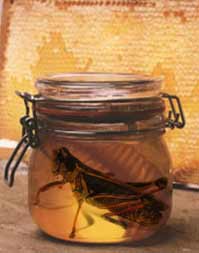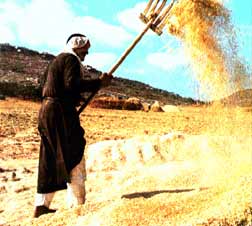...thoughts expressed here are not necessarily final.
September 20, 2004 Change of Life Sunday
Out pastor had a little faux pas yesterday in announcing next week's drive to collect change to benefit the local Crisis Pregnancy Center. He called it this in stead of "Change FOR Life" Sunday. I guess all the estrogen challenged ladies need recognition too.
September 20, 2004 Feast of Trumpets Time!
Some notes on the emergence of John the Baptist in Luke 3
| God’s call came to John in the wilderness,
in an obscure place. The place where John was reared was so slightly
populated that it was known as a wilderness. The area consisted of
only six small towns or villages scattered far apart. God found him
in the most obscure place. We do not know how John discerned his call.
John’s symbols Prophets were known by their poetic modus operandi. Elijah was known for his visions and Jeremiah for his object lessons. I find in John’s diet some very possible corollaries. |
 |
* Locusts are God’s chosen means of judgment, terror
and destruction in sundry examples in the OT. (Exodus, Joel, Jeremiah,
Nahum) They are especially useful to God in judging rebellious nations.
* Locusts created devastation by destroying the source of sustinence-
the crops. Therefore the harvest would be impacted
* Surprisingly , locusts were ceremonially clean.
* With John the source of the destruction becomes the source of blessing,
like manna, in the wilderness. This is in keeping with the OT paradigm-
what you meant for evil, God meant for Good.
* At this time approaching the Day of covering, So, I see some symbolism
in the idea of the covering of locusts with honey, if the honey was used
as a dip.
* The fallen activity of a fallen creation is thus redeemed.
* Honey is the sweetest and simplest of all foods in the OT. It is symbolic
of the Word of God.
* Honey also had medicinal qualities in Prov 16:24
* It often symbolized abundance and prosperity- the kind of spiritual
life John pointed to.
* In Isaiah 7:5 Immannual, the child of the sign eats curds and honey
and this is a sign of learning to choose righeousness.
* As a simple food it is an example of the blessing of self denial, identifying
John with Elijah to a land in need of repentance.
* God’s prophets likened the reception of divine revelation to eating
honey (Ezekiel 3:3, Rev 10:9-10, Ps 119:103).
The net effect of John's symbols is that through them, God took that which will eat your lunch and made them into lunch.
Grasshopper- one of the five major food groups.
"It is not generally known in the Western World that insects are a good source of protein. Taxonomically insects, such as locusts and crickets, are not far removed from shrimps, which are considered a delicacy in the West (The Malawi Cookbook 1979). In Central Africa the fried insects are served as a relish or as an appetizer. Relish refers to the sauce that is served with a stiff maize porridge.
Today they are sold whole, ready blanched. They are normally stir fried having a delicious nutty favor and crisp texture or served as a starter - and what a stunning way to start a meal."
John the Baptist Stir Fry
from http://www.osgrow.co.uk/index.php?document=22
|
Ingredients (serves 4) 10 Locusts |
 |
Method
Using a thick bottomed frying pan or a Wok, heat up the sesame
oil. Commence the stir fry with the ingredients that require the most
cooking, in this case the root ginger and the green pepper, followed by
the spring onions, the dates and the locusts. Add the honey and orange
juice, stirring all the time and cook for a few minutes.
Serve immediately and sprinkle the sesame seeds on the top. The stir
fry could be presented on a bed of saffron rice or on salad leaves. Alternatively
the part-cooked locusts can be fried with a little oil & salt, then
serve.
Mexican Grasshopper recipe
Ingredients:
* grasshoppers
* water
* oil
* Tortillas
* Garnish with lemon, salt, chili powder
Place live grasshoppers in water to clean them. They will die in the water.
Fry grasshoppers in oil, then garnish with lemon, salt and/or chili powder.
They can be eaten alone or can be placed in a tortilla. Roll up the tortilla
and eat.
God’s Timing for John:
The contest and date for this passage is likely Sept/Oct AD 28 according
to some commentators. Whether he burst on the scene at this time of year
or not, there are many corrollaries in the metaphors and signe of the
Baptizer and the Feast.
The
Feast of Trumpets is the first of the fall feasts. The Jewish people
call this feast Rosh Hashanah, which literally means "Head of the
Year," and it is observed as the start of the civil year (in contrast
with the religious year which starts with Passover) on the Jewish calendar.
That occurred this past week on the 16th.
The Feast of Trumpets is so important in Jewish thinking that it stands alongside Yom Kippur ("Day of Atonement" on Sept 25th this year)- to comprise what Judaism calls "the high holy days" on the Jewish religious calendar. It begins the "ten days of awe" before the Day of Atonement. According to Leviticus 23:24-27, the celebration consisted of a time of rest, "an offering made by fire," and the heraldic blowing of the trumpet or ram’s horn shofar. |
 |
Compare John's message of messianic hope with a Rosh
Hashanah prayer from an Orthodox Jewish prayer book: “May it be Your
will that the sounding of the shofar which we have done will be embroidered
in the veil by the appointed angel, as You accepted it by Elijah of blessed
memory and by Yeshua, the Prince of the Face [i.e. Prince of God’s
Presence] and the one who sits on God’s throne. May You be filled
with compassion toward us. Deserving of praise are You, Lord of compassion”
(Birnbaum, Behind The Curtain, p.282).
With this prayer, Jewish synagogues have invoked on Rosh Hashanah the
name of God’s coming King: Yeshua. Most Jewish rabbis insist that
this reference to Yeshua has nothing to do with Jesus, the anglicized
name for Yeshua (literally “salvation”).
John comes out of the wilderness trumpeting his heraldic
call: Prepare the Way!
Timeline: the Feast of Trumpets
The 10th day of 7th month, Tishri, the commercial/civil new year (religious
new year was Passover).
Note that commercial prosperity was tied in the minds of the Jews with
gaining God’s favor due to the rituals of this time- this forms a
key element of context for John’s message of fruits befitting repentance!
The harvest Feast of Tabernacles would be the week after Yom Kippur.The
chronology would go something like this, with some activities being concurrent:
* Head of the Year- Rosh Hashanah- Day of Judgment
* Blow trumpet to awaken sinners to repentance
* Halt labor
* Sacrifice
* A time of testing
* 10 days of awe, fasting, penitence
* Eating of bread and honey- Ho Lama- bread of affliction
* Culminated in Yom Kippur- covering day- The Day of Atonement
* No leather sandals were permitted on Yom Kippur
* Marked the forgiveness given by grace for the golden calf incident when
Moses descended Sinai with the second set of tablets.
True Repentance=Metanoia:
1. a change of mind, as it appears to one who repents, of a purpose he
has formed or of something he has done
Real, biblical repentance consists of
(1) a true sense of one's own guilt and sinfulness;
(2) an apprehension of God's mercy in Christ;
(3) an actual hatred of sin (Psalms 119:128; Job 42:5,6; 2co 7:10) and
turning from it to God; and
(4) a persistent endeavour after a holy life in a walking with God in
the way of his commandments.
 |
The true penitent is conscious of guilt (Psalms 51:4,9), of pollution (51:5,7,10), and of helplessness (51:11; 109:21,22). |
Therefore he apprehends himself to be just what God has always seen him to be and declares him to be. But repentance comprehends not only such a sense of sin, but also an apprehension of mercy, without which there can be no true repentance (Psalms 51:1; 130:4).
Here is the basic outline for Luke 3:7-20:
1.John the Baptist preached condemnation (v.7).
2.He preached repentance (v.8).
3.He preached humility (v.8).
4.He preached judgment (v.9).
5.He preached righteousness (v.10-14).
6.He preached the coming of the Kingdom (v.15-17).
7.He preached many other things (v.18).
8.He preached against sexual sin in high places (v.19-20).
 |
You can get your own camel's hair coat here. It might be a bit different from the one JB wore though. Two Button: Single Breasted |
John preached condemnation.
Note two things.
1.He preached the truth about men, what they were and had become. They
were ³vipers,² poisonous. They had allowed themselves to be poisoned and
were now poisonous to others. They were sick and doomed, and they were
biting others, making them sick and dooming them.
2. The rebuke ³Who warned you to flee?² compares the crowd to snakes
who flee their desert holes when the heat of a fire drives them out. Vipers
were commonly thought (cf. Herodotus) to eat their way out of their mothersı
wombs, killing mom in the process- so this is a pretty nasty saying- they
are far worse than just snakes. They would kill their own parent to survive.
Perhaps John was intimating that these parent killers were also killing
the true faith of their father Abraham. That's my take.
John's picture of the winnowing fork of the Messiahıs judgment.
Note these points.
a.The "fan" or winnowing fork is the Messiahıs power to pick
up both the wheat and the chaff.
b.The "floor" is the earth which will be purged or cleansed
of all chaff.
c.The "wheat" represents believers who truly repent and bring
forth fruit. They will be gathered into His barn (His kingdom or the new
heavens and earth).
d.The "chaff" represents those who only profess, who are counterfeit
wheat. They lie on the floor (the earth) with the wheat, but they are
not wheat. They shall be "burned with unquenchable fire."
| Note: A winnowing fork is a pitchfork-like tool used to toss threshed grain in the air so that the wind blows away the chaff, leaving the grain to fall to the ground. The note of purging is highlighted by the use of imagery involving sifting though threshed grain for the useful kernels. The winnowing process throws wheat and chaff together into turmoil for a purpose. |
Image from http://www.biblepicturegallery.com/free/Pics/Winnow.gif |
It is a sifting that occurs where the wind carries off the lightweight chaff and the heavier, more substantial wheat is separated out to stay on the earth. This is sort of the opposite picture of the traditional dispensational rapture imagery.
Another High School Class Reunion
This time it is Earnie's turn. She is looking forward to the festivities and linking up with old friends. We'll put on our dancing shoes and be there October 23.
|
Then |
Now |
Windows beseiged by hackers
Sometimes it's not fun being number one.
News from the Far East
|
I follow what is up in Myanmar especially
because we support a family there. |
 |
Accused of being insurrectionists because of past conflicts with tyrannous military regimes, ethnic people are victims of widespread rape, murder, torture and forced labor. After an influx of ethnic Burmese into neighboring Thailand, the Thai government established camps, where currently over 140,000 refugees live. Refugees live in constant threat of deportation by the Thai government, which has long ignored the international principle of non-refoulement (not forcing refugees to return to a country where they will be persecuted). Native Christian missionaries are reaching these tortured souls with the gospel. They hold crusades in refugee camps or in Thai cities where there are large populations of Burmese refugees. In one recent gospel meeting, over 100 came forward to accept Christ. Missionaries plant churches among refugees to nurture new believers. Ethnic Burmese Christians living in the camps bring the hope of Christ to their own people.


